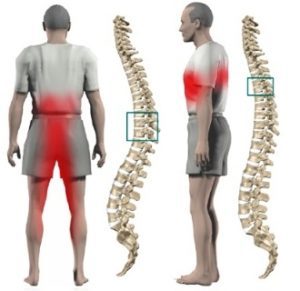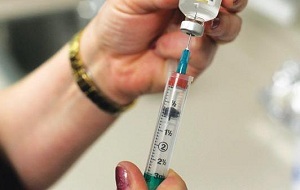Osteochondrosis of the lumbar spine, whose symptoms and treatment are varied, is one of the most common pathologies of the musculoskeletal system.
This condition is characterized by the development of degenerative-dystrophic changes of the intervertebral discs, extending over time to the ligaments of the lumbar spine and bone tissue. The acute process, in the absence of therapy, inevitably turns into a chronic process.
Degrees of lumbar spine osteochondrosisDegenerative disease can make a healthy person disabled.
Order 4 degrees of lumbar osteochondrosis. The scheme of development of the disease is as follows:
First degree.Cracks form in the inner part of the annulus fibrosis where the contents of the pulp nucleus reach, causing irritation. This is the initial stage of osteochondrosis. Deformity of the intervertebral discs is barely pronounced and causes reflex pain with sudden movements and heavy lifting. Unpleasant sensations in the lower part of the spine can be light and manifest:
Lumodina - local, prolonged pain in the lumbar region;Second degree.Destructive processes continue in Anbul fibrosus. The distance from one spine to another decreases, causing the nerve fibers to contract. There is discomfort in the lower back third, which sometimes escalates into pain attacks.
Third degree.During this period, the final destruction of anabolic fibrosis occurs during nuclear extrusion. Vessels and nerve endings are compressed by intervertebral discs. An intervertebral hernia is formed. The spine is a curve, forming:
- Lordosis - arcuate deformity of the lumbar spine, with a precursor to the spinal column;
- kyphosis - the opposite position of the lordosis when the arc is formed in the direction of the external direction;
- Scoliosis - abnormal bending of the spine to the right or left.
Recent GradeOsteochondrosis is considered to be the most severe and dangerous. By this time the spine is already deformed, normal motor activity is lost. X-rays show bone growth in the lumbar spine - a reaction of the body. The pain may not be there for a while, but it does not mean improvement. People with stage 4 osteochondrosis of the sacrum often become disabled. The reason is that the process is difficult at this stage.
Causes of lumbar spine osteochondrosis
Among the causes of lumbar osteochondrosis are the following:
- disproportionate load on the spine.Man is an erect creature, so in a standing position, the load on the spine is considered normal. When performing various actions, you need to move, bend and bend. The muscular system is in a state of prolonged tension to maintain the desired state of the body. When sitting, the load on the spine increases and when lying on the back, it becomes minimal. When a person is in one position for a long time, the lumbar and sacral parts of the spine are overloaded and the muscles do not rest, from which one first feels discomfort and then pain. This deforming factor creates the preconditions for the development of lumbar spine osteochondrosis.
- sedentary lifestyle.It contributes to the development of various pathologies, including those that affect the structures of the spine. Prolonged sitting causes deformation of cartilage tissue and decreased muscle tone, provoking the development of lumbar osteochondrosis.
- Excessive physical activity.Both lack of vigorous physical activity and its excess bring nothing good to the musculoskeletal system. Prolonged, hard work, especially associated with weight lifting and carrying, causes the spinal muscles to overload and spinal hernias to form.
- Postural disorders. Deformation of the discs between the vertebral areas can also be caused by improper gait. The reason is again the uneven load on the spinal column. Intervertebral discs lose elasticity, mobility and therefore the probability of injury. More than others, older and older people suffer from similar problems.
- Bone defects, hereditary pathologies, trauma and infectious lesions.Often, osteochondrosis is the result of disorders of the musculoskeletal system that existed at birth. For example, when the cartilage tissues of the body are naturally fragile. In addition, spinal pathologies develop after traumatic injuries and infectious processes, both during osteomyelitis and tuberculosis.
- Flat feet."Special" footprints are the hollows and folds of its arches. Those who have such a feature often have spinal problems. This is caused by increased load on the intervertebral discs while walking. Throughout their lives, they are subject to physical stress during increased movement, so they move quickly
- Obesity.Excess weight is a problem and an additional burden on the body. All organs and systems are affected including the spine.
- Abnormal processes.Dysfunction of various structures can adversely affect the condition of the musculoskeletal system. Thus, the factors that provoke osteochondrosis of the lumbar spine are endocrine disorders, cardiovascular problems and malfunctions of the digestive system.
- Wrong way of life.Many people do not pay enough attention to such simple and important things as physical activity, balanced diet and normal sleep. An organism that has been under stress for a long time becomes weakened and vulnerable. Other pathologies that may arise on such "fertile" soils include lumbar osteochondrosis.
Symptoms of lumbar spine osteochondrosis

Abnormal changes in the lumbar spine are manifested by acute symptoms;
- Lumbar painis the most obvious "signal" for the development of lumbar osteochondrosis. He speaks of the existence of ‘radicular syndrome’, when compression of the vertebral nerve endings causes lumbar spine pain. The person becomes tired and irritable. Over time, performing simple and routine actions becomes a big problem due to low back pain. If an intervertebral hernia has formed in the lumbar region, the pain radiates to the lower leg, back of the thigh, and leg. Over time, it becomes more and more difficult to sit and walk. Unpleasant sensations are not allowed even during bed. Temporary relief may alternate with periods of exacerbation.
- Disorders of the genitourinary system.They are manifested by pain in the kidneys, a frequent urge to urinate. Deformation of the intervertebral discs causes the lumbar spine to move relative to the spine. It affects the functioning of the internal reproductive organs in women, while in men it causes potency problems;
- Decreased foot sensitivity in the foot area.This can be partial or absolute. At the same time, the reflexes of this part of the body are weakened. Progressive pathology leads to complete loss of sensitivity of the lower extremities;
- Walking disorder.lumbar spine pain with osteochondrosis pushes a person while walking, deviating in the opposite direction where the nerve fibers intersect. The condition does not allow you to walk long distances. The lame person is forced to stop from time to time in anticipation of pain relief. Timely medical care can save a person from disability.
Treatment of lumbar spine osteochondrosis
Many people are interested in the treatment of osteochondrosis of the lumbar spine and how it is done. Therapeutic tactics are defined when diagnosing and diagnosing.
There are various methods used to treat lumbar osteochondrosis. Which of them is necessary and desirable to use to cure the disease or to alleviate the human condition as much as possible, determines the doctor.
Someone treats themselves only with folk remedies, at home, forgetting that they can be used only with the consent of a medical specialist and only as part of a complex therapy.
Medications for osteochondrosis
Drug therapy includes:
- use of- tablet forms;
- injection solutions;
- External preparations - ointments and gels.
Medications are prescribed that eliminate inflammation and relieve pain in the lumbar region. They can also be used at home.

This could be:
- Analgesics;
- Nonsteroidal anti-inflammatory drugs;
- Medications for muscle spasms (muscle relaxants);
- means cartilage repair (chondroprotectors);
- Corticosteroids (hormone-containing drugs that relieve pain and inflammation)
- Vitamins.
A course of treatment is prescribed by a doctor who sometimes prescribes pills or medications to calm the nervous system as an adjunct treatment.
Physiotherapy for lumbar osteochondrosis
Physiotherapy is another common method of relieving the symptoms of lumbar osteochondrosis. Acts on the spine and spine, it enhances metabolic and restorative processes.
Most commonly prescribed:
- Magnetic, laser and electrotherapy;
- phonophoresis;
- shock wave method;
- protective therapy;
- vibration massage;
- Balneotherapy.
How many and what procedures will be needed - the doctor will decide.
Physiotherapy is effective when it comes to the early stages of pathology. But it, like other treatments, has contraindications. Therefore, when prescribing this method, the doctor takes into account many factors.
Therapeutic gymnastics for lumbar osteochondrosis
A set of physical exercises that can be performed during lumbar osteochondrosis is aimed at restoring the mobility of this spine.
Regularity is considered to be the main condition for its effectiveness. Sometimes the exercises performed will not bring the desired effect.
If the body already has complications caused by osteochondrosis, this method is not used. In addition, its use is contraindicated in acute pathologies of other organs and systems, as well as the presence of pain in the pelvic region and above.
Surgical intervention in osteochondrosis of the lumbar spine
The surgical method is used in the presence of severe complications such as interstitial hernia. Partial or complete removal of the damaged intervertebral disc (discectomy) is performed as provided in the operation protocol.
Indications forare:
- A strong and persistent pain syndrome that cannot be relieved with medication within a month;
- Large size of the hernia and its effect on the spinal cord.
Osteochondrosis is easier to prevent than to cure. Like any pathology, it is potentially dangerous with severe complications. It is important to understand that more or less complete destruction of this pathology is possible in the early stages when the deformed effect on the intervertebral discs is minimal. In other cases, we can talk only about alleviating the symptoms and maintaining the condition of the body, allowing you to live and work normally.














































